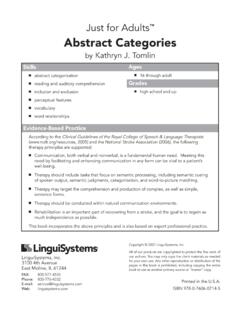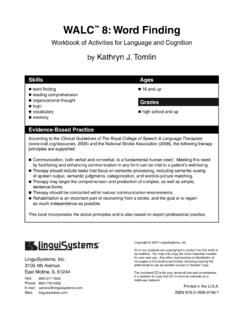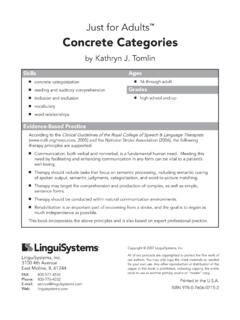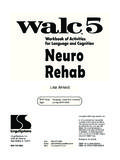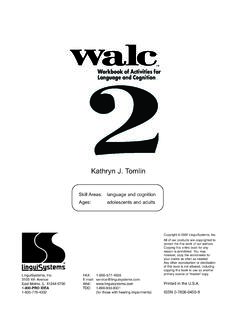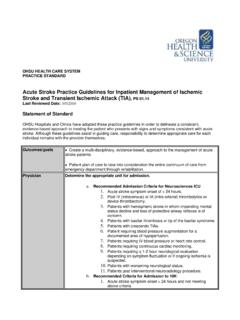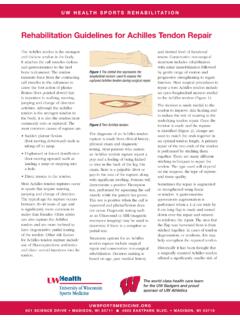Transcription of WALC - Affiliated Rehab
1 WALC 1 TM. Workbook of Activities for Language and Cognition Aphasia Rehab by Kathryn J. Tomlin Skills Ages I I. Matching and identification 16 through adult I Following commands Grades I Vocabulary I. I Answering questions high school and up I Functional language Evidence-Based Practice According to the Clinical guidelines of the Royal College of Speech & Language Therapists ( , 2005) and the National Stroke Association (2006), the following therapy principles are supported. I Communication, both verbal and nonverbal, is a fundamental human need.
2 Meeting this need by facilitating and enhancing communication in any form can be vital to a patient's well-being. I Therapy should include tasks that focus on semantic processing, including semantic cueing of spoken output, semantic judgments, categorization, and word-to-picture matching. I Therapy may target the comprehension and production of complex, as well as simple, sen- tence forms. I Therapy should be conducted within natural communication environments. I Rehabilitation is an important part of recovering from a stroke, and the goal is to regain as much independence as possible.
3 This book incorporates the above principles and is also based on expert professional practice. Copyright 2002 LinguiSystems, Inc. All of our products are copyrighted to protect the fine work of our authors. You may only copy the worksheets as needed for your own LinguiSystems, Inc. use with clients. Any other reproduction or distribution of the pages in this book is prohibited, including copying the entire book to use 3100 4th Avenue as another primary source or master copy. East Moline, IL 61244-9700. The enclosed CD is for your personal use and convenience.
4 It is 800-776-4332 unlawful to copy this CD or store its content on a multi-user network. FAX: 800-577-4555 Printed in the E-mail: ISBN 10: 0-7606-0424-X. Web: ISBN 13: 978-0-7606-0424-3. About the Author For more than 25 years, Kathryn J. Tomlin, , CCC-SLP, has worked with children, adolescents and adults with impairments in communication, oral-motor skills and swallowing due to various etiologies. She is also the author of these therapy books: z WALC 2 Cognitive Rehab z WALC 8 Word Finding z WALC 9 Verbal and Visual Reasoning z WALC 10 Memory z WALC 11 Language for Home Activities z The Source for Apraxia Therapy Zanmi, Kathy's Samoyed, goes to work with her to encourage Kathy & Zanmi the clients.
5 They enjoy feeding and spending time with Zanmi, and Zanmi distracts them from their present situations and their communication difficulties. Everybody wins! Acknowledgment Much thanks to all of my co-workers, friends, family, and especially my clients, who have taught me so much. Illustrations by Tony Vandercar and Margaret Warner WALC 1: Aphasia Rehab Copyright 2002 LinguiSystems, Inc. Table of Contents Introduction .. 5. Unit 1: Matching and Identification Introduction .. 6. Matching .. 7. Identification .. 22.
6 Unit 2: Following Commands Introduction .. 50. Following Commands .. 51. Unit 3: Vocabulary Introduction .. 60. Opposites .. 61. Synonyms .. 67. Associations .. 73. Definitions .. 79. Categories .. 95. Unit 4: Answering Questions Introduction .. 110. Listening for Embedded Information .. 111. Answering Questions .. 124. Unit 5: Functional Language Introduction .. 157. Sentence Completion .. 158. Paragraphs .. 191. Reading and Writing .. 200. Answer Key .. 214. WALC 1: Aphasia Rehab Copyright 2002 LinguiSystems, Inc.
7 Introduction The exercises in WALC 1 (Workbook of Activities for Language and Cognition): Aphasia Rehab emerged as was working with adolescent and adult clients who exhibited difficulties with auditory and visual comprehension and/or oral and written expression. The majority of these clients exhibited aphasia due to stroke or head injury. These exercises have also proved to be very useful with clients who have language difficulties resulting from various pathologies ( , central auditory processing disorders) as well as neurologic changes due to illnesses ( , Lyme disease).
8 The underlying principle for the materials in WALC 1: Aphasia Rehab is based on teaching processes as opposed to content. My focus has been on teaching strategies and I have discovered that few publications contain a sufficient amount of stimulus items to insure acquisition of the strategy. Most available material does not provide an internal hierarchical order which reflects an increase in degree of difficulty within a task and from task to task as the client builds upon the strategies of processes he is relearning how to use.
9 The exercises in WALC 1: Aphasia Rehab have been used for many years by speech- language pathologists and other specialists ( , cognitive therapists, occupational therapists) with a wide variety of clients. The content and format have proved to be an excellent therapy supplement for trained professionals, clients' families, and clients. However one uses WALC 1: Aphasia Rehab , it is my sincere hope that the exercises are helpful and that each and every client will benefit from having used them. Kathy WALC 1: Aphasia Rehab 5 Copyright 2002 LinguiSystems, Inc.
10 Unit 1: Matching and Identification A client's ability to understand and complete matching and identification tasks is often impaired as a result of aphasia. The client may have lost the ability to determine how shapes, numbers, letters, or words are alike or different. A client may no longer understand what the concept of matching means. For clients with anomia, the matching and identification tasks stimulate expressive language, making the use of these activities especially helpful for them. The matching and identification tasks begin simply, with single, more concrete items (that are not loaded with meaning) and progress to more complex tasks.
